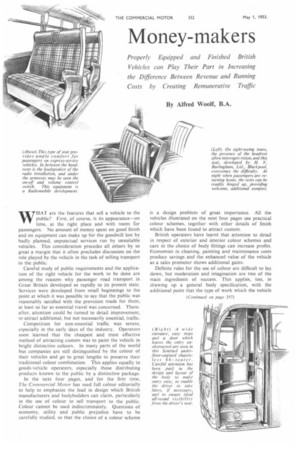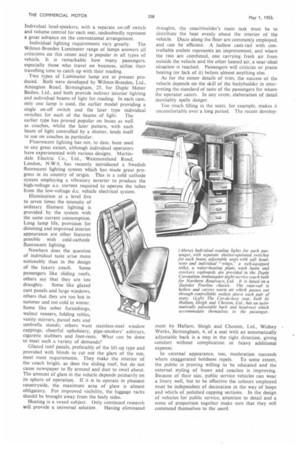Money-makers
Page 114

Page 119

Page 120

If you've noticed an error in this article please click here to report it so we can fix it.
Properly Equipped and Finished British Vehicles can Play Their Part in Increasing the Difference Between Revenue and Running Costs by Creating Remunerative Traffic By Alfred Woolf, BA.
WHAT are the features that sell a vehicle to the public? First, of course, is its appearance—on time, at the right place and with room for passengers. No amount of money spent on good finish and on equipment can make up for the goodwill lost by badly planned, unpunctual services run by unsuitable vehicles. This consideration precedes all others by so great a margin that it often precludes discussion on the role played by the vehicle in the task of selling transport to the public.
Careful study of public requirements and the application of the right vehicle for the work to be done are among the reasons why passenger road transport in Great Britain developed so rapidly to its present state. Services were developed from small beginnings to the point at which it was possible to say that the public was reasonably satisfied with the provision made for them, at least so far as essential travel was concerned. Thereafter, attention could be turned to detail improvement, to attract additional, but not necessarily essential, traffic.
Competition for non-essential traffic was severe, especially in the early days of the industry. Operators soon learned that the cheapest and most effective method of attracting custom was to paint the vehicle in bright distinctive colours. In many parts of the world bus companies are still distinguished by the colour of their vehicles and go to great lengths to preserve their traditional colour combination. This applies equally to goods-vehicle operators, especially those distributing products known to the public by a distinctive package.
In the next four pages, and for the first time, The Commercial Motor has used full colour editorially to help to emphasize the lead in design which British manufacturers and bodybuilders can claim, particularly in the use of colour to sell transport to the public. Colour cannot be used indiscriminately. Questions of economy, utility and public prejudice have to be carefully studied, so that the choice of a colour scheme is a design problem of great importance. All the vehicles illustrated on the next four pages use practical colour schemes, together with other details of finish which have been found to attract custom.
British operators have learnt that attention to detail in respect of exterior and interior colour schemes and care in the choice of body fittings can increase profits. Economies in cleaning, painting and maintenance costs produce savings and the enhanced value of the vehicle as a sales promoter shows additional gains.
Definite rules for the use of colour are difficult to lay down, but moderation and imagination are two of the main ingredients of success. This applies, too, in drawing up a general body specification, with the additional point that the type of work which the vehicle
is intended to do must be the deciding factor in the final choice of equipment.
Broadly speaking, three types of vehicle must be considered. First, the service bus; secondly, the express or inter-urban vehicle, which must be designed to facilitate its use in later years as a service vehicle, and, thirdly, the luxury coach. I will review some of the features which British operators and bodybuilders have found to be satisfactory in operation and have been stamped with the mark of public approval.
In a service bus, ease of entry and of movement about the vehicle must be a priority. A wide entrance, with a door to prevent the entry of cold air or the escape of warmth, is essential. The door itself must fold entirely out of the way so as not to impede the progress of passengers boarding and alighting.
Even in rush hours, passengers may be carrying parcels or brief-cases, and a doorway partially obstructed by the door itself, 'or by hand rails so positioned as to trap a passenger's hand or umbrella, can soon play havoc with schedules. Adequate lighting of the steps—which should be as few as possible—is equally essential.
Once inside the bus, the passenger must he able to move freely either into a seat or to a position where his presence will not obstruct other passengers or the conductor. The extra width available in a body using light-alloy framing and fitted with compact seats which do not overhang the gangway is worth minutes to the traffic manager.
If parcel racks are fitted, they too, must be out of the way and yet accessible. In their absence, provision should be made for passengers to leave cases and the like near the exit, so that they do not have to carry them on their laps or leave them in the gangway. In double-deckers, the space under the stairs is most convenient for this use. Some operators specify a type of staircase which limits the number of seats slightly, but they believe that it is better to provide the passenger with somewhere to leave his parcels or folding pushchair and to encourage him to board even a full bus.
Australasian operators often provide pram hooks on the front panel or a deep compartment under the floor accessible from the outside. This is left open to speed up loading and unloading. This sort of detail makes all the difference: especially on suburban services, between a paying route and an uneconomic one. Passengers will shop nearer their homes rather than travel on a bus which makes no provision for such needs.
Ventilation, visibility and noise are other matters which must be carefully considered in a bus. Ventilating windows must be of a type which does not rattle, is easily operated and is effective. For these reasons, top-sliding windows have become almost standard in recent years. A type of ventilator which overcomes draught has recently been developed for Keith and Boyle, Ltd., Terminal House, Clapham Road, London, S.W.9, and seems to meet all requirements, especially as one can tell at a glance how to operate it.
As with all types of public service vehicle, the service bus must he easy to clean. Polished-alloy hand rails, curved cove panels, anti-condensation materials on roofs, and traps designed to prevent the collection of dust and used tickets are pointers in the right direction.
In an express coach, too, all these requirements must be met. The seating, however, must be the subject of rather more careful consideration. Here the object is to combine comfort with reasonable dimensions, so that the maximum number can be fitted without reducing leg-room too much. Individual and adjustable scats are too bulky, but a compromise can be reached with an armrest on the gangway side and individual head-rests.
The subject of radio in vehicles of any kind is still surrounded by controversy. On an express service, as with the touring vehicle, it may often prove an appreciated feature, especially where some part of the journey is made during the hours of darkness. Individual loud-speakers, with a separate on-off switch and volume control for each seat, undoubtedly represent a great advance on the conventional arrangement.
Individual lighting requirements vary greatly. The Wilmot-Breeden Luminator range of lamps answers all criticisms on this count and is popular in all types of vehicle. It is remarkable how many passengers, especially those who travel on business, utilize their travelling time to catch up with their reading.
Two types of Luminator lamp are at present produced. Both were developed by Wilmot-Breeden, Ltd., Amington Road, Birmingham, 25, for Duple Motor Bodies, Ltd., and both provide indirect interior lighting and individual beams of light for reading. In each case, only one lamp is used, the earlier model providing a single on-off switch and the later type individual switches for each of the beams of light. The earlier type has proved popular on buses as well as coaches, whilst the later pattern, with each beam of light controlled by a shutter, lends itself to use on coaches in particular.
Fluorescent lighting has not, to date, been used to any great extent, although individual operators have experimented with various designs_ Martindale Electric Co., Ltd., Westmoreland Road, London, N.W.9, has recently introduced a Swedish fluorescent lighting system which has made great progress in its country of origin. This is a cold cathode system employing a vibratory inverter to produce the high-voltage a.c. current required to operate the tubes from the low-voltage d.c. vehicle electrical system.
Illumination at a level five to seven times the intensity of ordinary filament lighting is provided by the system with the same current consumption. Long lamp life, provision for dimming and improved interior appearance are other features possible with cold-cathode fluorescent lighting.
Nowhere does the question of individual taste arise more noticeably than in the design of the luxury coach. Some passengers like sliding roofs, others say that they are too draughty. Some like glazed cant panels and large windows, others that they are too hot in summer and too cold in winter. Some like sober furnishings, walnut veneers, folding tables, vanity mirrors, parcel nets and umbrella stands; others want stainless-steel window cappings, cheerful upholstery, pipe-smokers' ashtrays, cigarette stubbers and foot-rests. What can be done to meet such a variety of demands?
Glazed roof panels, preferably of the lift-up type and provided with blinds to cut out the glare of the sun, meet most requirements. They make the interior of the coach bright, as does the sliding roof, but do not cause newspaper to fly around and dust to swirl about. The amount of glass in the vehicle depends primarily on its sphere of operation. If it is to operate in pleasant countryside, the maximum area of glass is almost obligatory. For improved visibility, the luggage racks should be brought away from the body sides.
Heating is a vexed subject. Only continued research will provide a universal solution. Having eliminated draughts, the coach builder's main task must be to distribute the heat evenly about the interior of the vehicle. Ducts along the floor are commonly employed, and can be efficient. A hollow cant-rail with controllable outlets represents an improvement, and where the two are combined, one carrying fresh air from outside the vehicle and the other heated air, a near-ideal situation is reached. Passengers will criticize or praise heating (or lack of it) before almost anything else.
As for the minor details of trim, the success of the vehicle depends on the skill of the bodybuilder in interpreting the standard of taste of the passengers for whom the operator caters. In any event, elaboration of detail inevitably spells danger.
Too much filling in the seats, for example, makes it uncomfortable over a long period. The recent develop
ment by Hallam, Sleigh and Cheston, Ltd., Widney Works, Birmingham, 4, of a seat with an automatically adjustable back is a step in the right direction, giving comfort without complication or heavy additional expense.
In external appearance, too, moderation succeeds where exaggerated boldness repels. To some extent, the public is proving willing to be educated and the external styling of buses and coaches is improving. Because of their size, public service vehicles can wear a livery well, but to be effective the colours employed must be independent of decoration in the way of loops and whirls of polished capping sections. In the design of vehicles for public service, attention to detail and a sense of proportion together make sure that they will commend themselves to the userl.








































































































































































































































